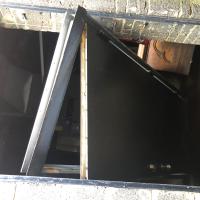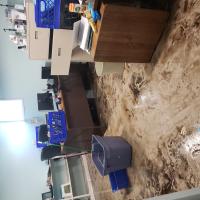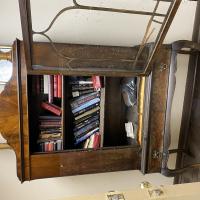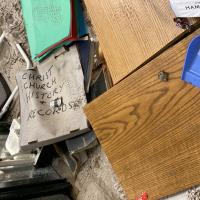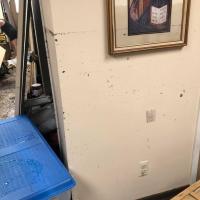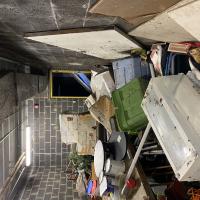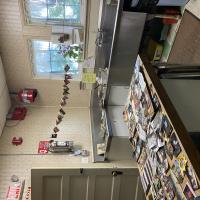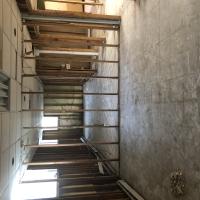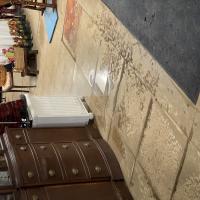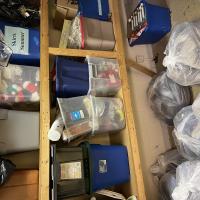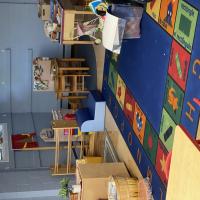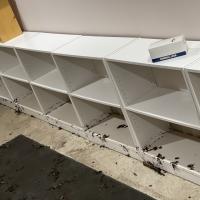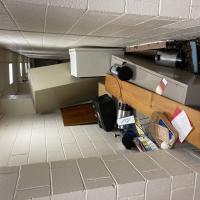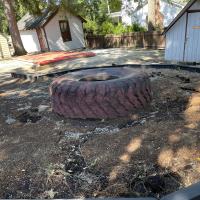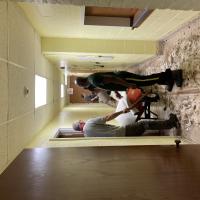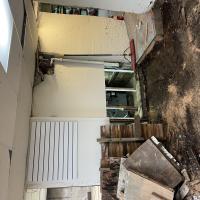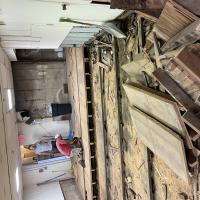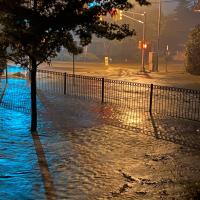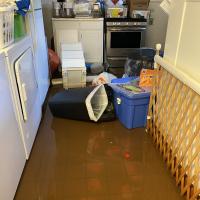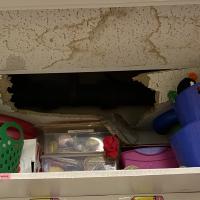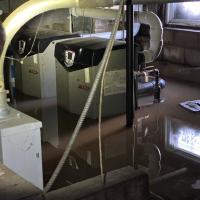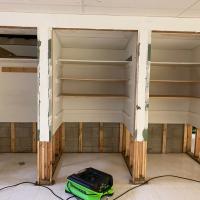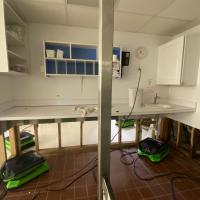
“That was definitely a wild night,” said the Rev. Paula Toland. “We saw our neighbors’ cars floating” by St. Stephen’s, Millburn, where she serves as Rector.
“We have a sexton who lives on property – he and his wife had to run to get out of the way when the water rushed in,” said Pam Fueshko, Warden at St. Peter’s, Clifton.
When the Rev. Nate Darville, Rector of St. Peter’s, Essex Fells, got a phone call from his property manager early the next morning, the first words out of his mouth were, “How bad is it?”
“It’s pretty bad,” came the reply. “It’s the worst that I’ve seen.”
The three congregations led by Toland, Fueshko and Darville were among those most severely affected when the remnants of Hurricane Ida came through New Jersey the night of September 1-2, 2021. Six weeks into their recovery, they shared their experiences.
At St. Peter’s, Clifton, the flood water forced the steel fire door to the sub-basement right out of its frame. Flooding reached six feet in the sub-basement and traveled up the stairwell into the lower-level office space, which received more than four feet of water, said Fueshko, “basically destroying everything that we had – tossing furniture around, covering electronic equipment.”
Also flooded was a storage room for St. Peter’s Haven, a program helping the hungry and homeless. “Backpacks and school supplies, towels, clothing, hygiene items – all of that was completely lost in addition to all the office equipment and files,” she said.
Also lost was the church’s brand-new hot water heater, which had been installed the week before the storm, as well as all the decorations for the church.
“Thankfully upstairs, which is where the food pantry for St. Peter's Haven is housed, we did not receive any damage,” Fueshko said. “The very next morning we were able to continue distributing food to those who showed up for their appointments.”
Fueshko said her first phone call was to the Church Insurance Company, who had a restoration and mitigation company there by Friday. “They said, ‘This is a lot, and we hope you realize that this is going to take a while in order to clear this out.’”
Volunteers pitched in immediately to clean up the church, which received water but was not severely flooded. “We were able to dry out the church so that we could continue to hold our church services that Sunday. We have two additional churches that rent from us, and they were able to hold their services as well on that Saturday and the Sunday afternoon after hours.”
The flood waters did leave a lingering odor, which they dealt with liturgically. “That first weekend, the Rev. Canon Dr. Kevin Moroney, who is our Priest-in-Residence, incensed the church,” said Fueshko. “Even though we had the ceiling fans on, the door is wide open, there was a strong odor of the water in the church and in the parish hall.”
A lack of dumpsters was a challenge for the clean-up efforts. “I've lived here my entire life,” said Fueshko, “and Clifton has never had the kind of flood damage that we had from Ida, so the city had basically taken every dumpster available. At one point, our parking lot was half full with the debris. Thankfully, the city came to our rescue, and we probably removed about 20 dump trucks full of debris.”
The flooding in the office damaged important historical records. “Christ Church, Belleville joined us about 10 years ago and we still had some of their documentation dating back to the 1700s, and that was waterlogged.”
To salvage the wet documents and photos, volunteers have laboriously separated them and spread them out on every surface they could find, or hung them on lines strung across the kitchen.
“I think the most important thing we've learned is to scan all your critical documents and keep them in the cloud or somewhere else,” said Fueshko. “Do not rely on paper documents. That has been our biggest challenge – salvaging and now trying to scan everything that we need to keep. Annual reports, parochial reports, letters of transfer – all those kinds of things – scan them and keep them in the cloud.”
Currently, all the rooms on the flooded office level have been gutted to the studs, sprayed for mold and dried out. “We’re just waiting on a final report as to what will be covered or not covered from the insurance company, and as soon as they give the go-ahead, we will start the rebuild with some minor adjustments,” Fueshko said. She hopes to waterproof the space, as well as address the issue of water coming from the properties behind the church.
At St. Peter’s, Essex Fells, Darville said the worst casualty was to their Op Shop, a non-profit thrift shop that sells gently used clothing and small home goods, using the proceeds to support community outreach programs. Volunteers had used the shop’s August break to convert the shop to fall inventory and planned a grand fall re-opening for Saturday, September 11, with the proceeds going to a September 11th charity.
“That was not able to happen,” said Darville. “All of the inventory was lost, it had to be tossed.”
Flooding also damaged St. Peter’s Sunday school and nursey school classrooms. “A lot of things are on a lower level for kids, so a lot of the materials for both the nursery school and the Sunday school were all soaked – rugs were soaked and there was just water and sediment everywhere.”
The impact to the Sunday school and nursey school extended outdoors. “Since it's Covid we're dependent upon having a lot of outdoor space, when weather is permitting, for classroom space, and we have a very nice playground,” Darville said. “That was completely washed away.”
Flood waters even blew open the steel-reinforced wood doors to St. Peter’s undercroft, which houses the church’s kitchen, lounge, bathrooms and choir room, as well as a new classroom still in the process of being built.
“They were just all covered in water,” said Darville. “All of the choir robes and the acolyte robes as well.”
The congregation had to scramble. “We were set to start Sunday school for the first time since Covid,” he said. They managed to move it to an alternative space, as well as the nursery school, which was set to start Monday, September 13.
“We didn't have any vestments for members during the liturgy. The choir was not able to rehearse in their choir space,” Darville said. “But we've been able to do as best as we can. We've had to learn to pivot at the last minute, as the Bishop has said, with Covid, so we're able to move really quickly to get things going.”
As for the Op Shop, “We have no opening date as of yet because of how massive the damage was in the thrift shop.”
Darville was able to get a remediation company in the Monday after the flood, and he and the Wardens arranged a parish clean-up day at which about two dozen volunteers showed up. “Time was of the essence. We spent a ton of time vacuuming water out and getting everything we could out of the wet areas so that there wouldn't be mold and so that we could save as much as we could.”
With the first step of the clean-up complete and the flooded areas re-certified for use, Darville says he and the Vestry are going to pause before taking the next two steps: rebuilding, and implementing preventative measures.
“We really have to make sure that this doesn't happen again,” he said, adding that the church was also damaged by a lesser, but still serious, flood in 2018. “It was a tremendous blow to us, not only financially but also spiritually and from a morale sense.”
Noting that Bishop Hughes and Canon Wright visited the campus to survey the flood damage on September 15 – the first anniversary of his ministry at St. Peter’s – Darville said, “we've also been very appreciative of people in the greater diocesan family reaching out to us, and it's meant a lot to us.”
Darville recommends that all parishes learn from their experience and evaluate whether they might be at risk for flood damage. “Look at that seriously and possibly do something preventative, so that they don't have to experience what we experienced, because it's very overwhelming to deal with.”
St. Stephen’s congregation was forced out of their building for five weeks after being declared a Category 3 cleanup site due to contaminated flood waters in Millburn.
“We had dead fish on the lawn, it was obvious that we had sewage on the lawn,” said Toland. There were dead animals in the flooded crawlspaces under the church, she said.
When she tried to go downstairs to inspect two of their big preschool classrooms, “the vile flood water was at the level of the second stair and it was obvious those classrooms were gone for all intents and purposes.”
Their 10-month-old, $42,000 heating system was immersed in five feet of flood water. A second heating system for the multi-building campus was submerged in seven feet of water. They lost both hot water heaters and the kitchen appliances in the flooded preschool area.
Although the church itself was not flooded, the water from the flooded crawlspaces underneath seeped up and did further damage.
“The building smelled really, really bad for a while,” she said. “We had a mold issue that was very quickly apparent in in the nave – we could not spend longer than five minutes in there without burning eyes.”
“We're not even at the point yet where we know [the full extent of the flood damage]. I can't quantify it yet because we're still in the process of quantifying it.”
The preschool was scheduled to welcome 68 to 72 children the following Monday. “We were able to make some adjustments,” Toland said, converting the space above her office into a classroom. “We got SERVPRO in here to do what needed to be done so we could safely open the building the following Monday, but what that meant was that we are still limited to that 68 or 72 children. We were looking forward to being able to bring in some of the children off our wait list, some of whom have been wait listed since they were infants who would now be in our two-year-old classroom, and we said we can't do that until we're back.”
The juggling of St. Stephen’s limited usable space to enable the preschool to open had the unfortunate side effect of postponing their new youth group program. “We just hired a fabulous young woman, a children and youth minister,” said Toland. “We were going to start a youth group twice monthly youth group in the space above my office and that's now a classroom.”
“That has been, I think, one of the hardest disruptions,” Toland said, “because when I was called, part of it was to rebuild ministry with children and families.”
Their recovery has been slow going. “The reality was there wasn't anything anybody could do as a volunteer for three weeks because we are a Category 3 cleanup site – you need the professionals, and other contractors wouldn't come in until that was done.”
Since the hazardous clean-up was completed, “we've had some of the work done. We've encountered lots of delays because of pre-existing supply chain issues. We're at the mercy of contractors – they're all good and reliable people, but everybody and their great-uncle in this area has need of a contractor and a plumber and an electrician.”
Amidst the disruption and the disappointments caused by Hurricane Ida, St. Stephen’s congregation is finding hope in relationships.
Especially disheartening for the congregation was that they had only been back in their church for worship for three months due to the pandemic, when they were evicted again by the hurricane. “It was a huge disruption made less horrible because we have such a good relationship with Christ Church in Short Hills,” Toland said. “The day after, [the Rev.] Bowie Snodgrass and [the Rev.] Tristan Shin [of Christ Church] were sitting in my office saying, ‘Of course you and your people will come to Christ Church on Sunday.”
“So we were able to worship there, and a number of us did every Sunday for five Sundays,” until they were able to return to worship at St. Stephen’s on October 10.
The congregation is reaching out to their own neighbors as well. “The Sunday after the flood, we hosted a cookout for our neighbors, many of whom, they're still not in their homes,” Toland said. “And I put that as part of our recovery effort because that was really our spiritual recovery. We couldn't be in our building, we couldn't use the space the way we typically could, but we made a choice that we want to live our faith. We weren't going to let the flood keep us from living our faith and we're the church on Main Street where love begets love, and that was a way we could show it. And we fed over 30 people and people said, “Wow, this is what we needed to know that we get to still be church, even if we can't be church in church.”
“We've been talking a lot since Covid about reimagining church or being church differently and learning that the church is so much more than what happens in the building or a specific part of the building.
“We're a small parish, we don't have an endowment, we don't have a property fund that we can call upon to get stuff done immediately, we need to wait for the insurance company to make a decision – and it still didn't stop us from being the community that we are and from living our faith in the ways that we think God calls us to do.
“I think that's an important learning because I’ve known it in my head and in little ways, but man, a violent flood brings it home. Maybe I’m a poster child for the Bishop's message to clergy and lay people for these past three years that we are not church by ourselves, we are part of something bigger – the relationships you make just in the everyday of being church.”

